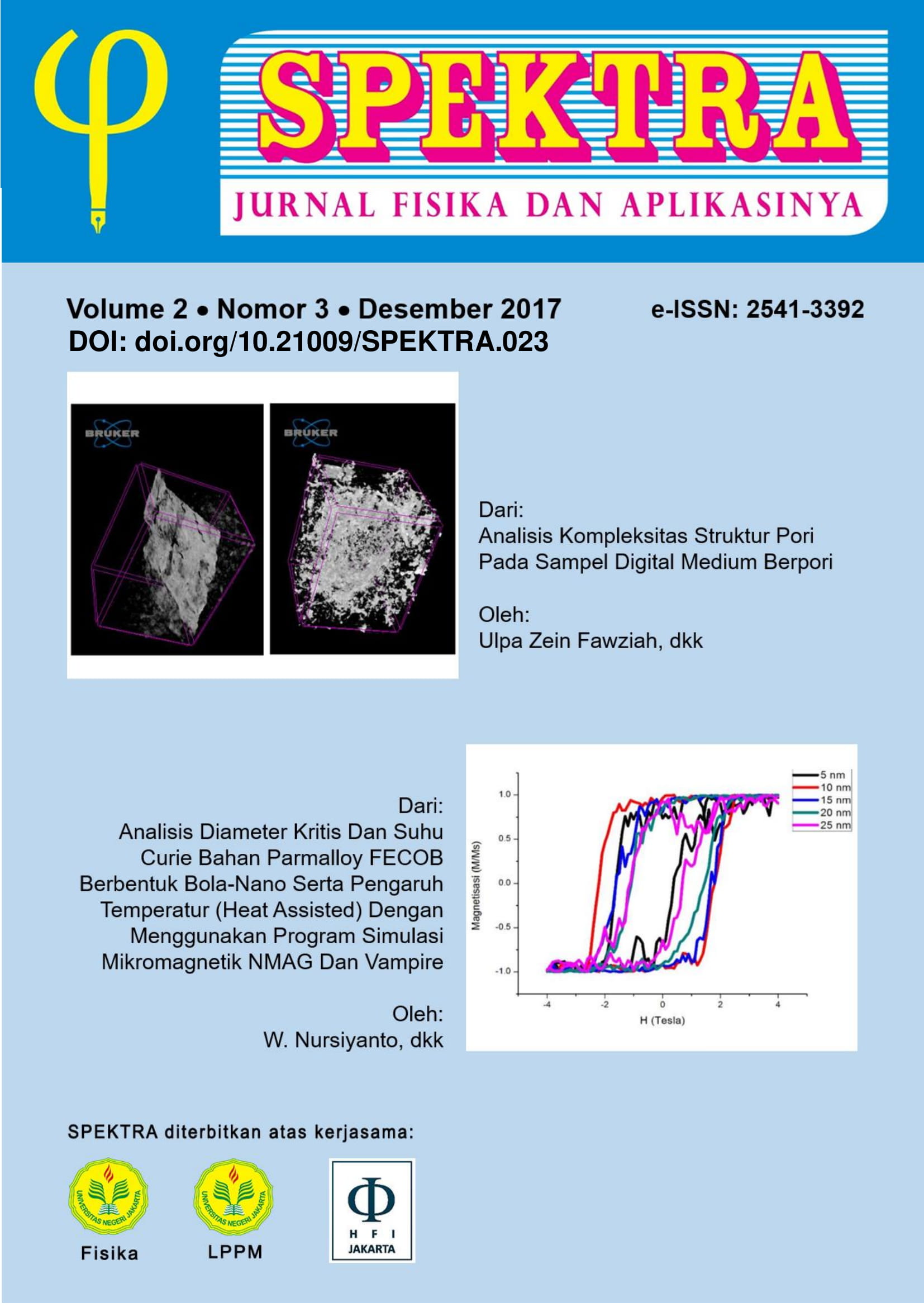ANALISIS KOMPLEKSITAS STRUKTUR PORI PADA SAMPEL DIGITAL MEDIUM BERPORI
DOI:
https://doi.org/10.21009/SPEKTRA.023.06Abstract
Abstrak
Kompleksitas struktur pori terhubung pada sampel digital medium berpori 2D telah dianalisis menggunakan parameter tortuositas. Jalur pori terhubung dilacak dengan menggunakan Simple Neurite Tracer. Metode pelacakan dan perhitungan tortuositas tersebut diujikan pada lima model sederhana yang menunjukan perbedaan tingkat kompleksitas yang signifikan. Metode analisis kompleksitas tersebut kemudian diterapkan pada sampel medium berpori berupa citra digital batuan berukuran 560 × 393 piksel, dan tanah berukuran 560 × 475 piksel. Citra digital sampel tanah dan batuan yang dianalisis berupa irisan 2D pada bidang z-y (sagittal) yang diambil dari sampel 3D hasil pemindaian menggunakan -CT Scanner SkyScan 1173. Pelacakan jalur pori terhubung pada sampel model maupun sampel digital 2D batuan dan tanah yang menggunakan Simple Neurite Tracer menghasilkan koordinat jalur pori terhubung yang kemudian digunakan untuk menghitung nilai tortuositas. Tortuositas dihitung dengan menggunakan definisi rasio antara jumlah total sudut keberlikuan jalur terhadap jarak antara dua sisi sampel yang saling berhadapan. Untuk 5 sampel model yang menunjukkan kompleksitas yang berbeda, diperoleh bahwa semakin kompleks struktur pori tersebut, maka semakin besar nilai tortuositasnya. Untuk analisis pada sampel digital batuan, nilai tortuositasnya yaitu 0,0392 sedangkan pada sampel tanah didapat nilai tortuositas sebesar 0,0431.
Kata-kata kunci: simple neurite tracer, tortuositas, kompleksitas, medium berpori
Abstract
The complexity of the connected pore structure of 2D porous digital media samples has been analyzed using tortuosity parameter. Connected pore was traced using the Simple Neurite Tracer. The tracing method and the tortuosity calculation were tested on five simple models showing significant differences in complexity levels. The complexity analysis method was then applied on digital image of a rock sample with the size of 560 × 393 pixels, and a soil sample with the size of 560 × 475 pixels. Digital images of the rock and soil samples were analyzed on the 2D slices in the zy (sagittal) plane which were obtained from the scanned 3D samples using the µ-CT SkyScan 1173 Scanner. Connected pore tracing for both the 2D models as well as the rock and soil samples was done using the Simple Neurite Tracer which produce the coordinate of the connected pore path which is then used to calculate the value of tortuosity. Tortuosity is calculated by using the definition of the ratio between the sum of the curvaceous angles of the connected pore path to the distance between two facing sides of the sample. For 5 sample models with distinctive complexity, it was found that the more complex the pore structure, the greater the tortuosity value. For analysis on digital samples of rocks, the tortuosity is 0.0392 whereas in the soil sample, the tortuosity is 0.0431.
Keywords: simple neurite tracer, tortuosity, complexity, porous medium.
Downloads
Published
How to Cite
Issue
Section
License
SPEKTRA: Jurnal Fisika dan Aplikasinya allow the author(s) to hold the copyright without restrictions and allow the author(s) to retain publishing rights without restrictions. SPEKTRA: Jurnal Fisika dan Aplikasinya CC-BY or an equivalent license as the optimal license for the publication, distribution, use, and reuse of scholarly work. In developing strategy and setting priorities, SPEKTRA: Jurnal Fisika dan Aplikasinya recognize that free access is better than priced access, libre access is better than free access, and libre under CC-BY or the equivalent is better than libre under more restrictive open licenses. We should achieve what we can when we can. We should not delay achieving free in order to achieve libre, and we should not stop with free when we can achieve libre.
 SPEKTRA: Jurnal Fisika dan Aplikasinya is licensed under a Creative Commons Attribution 4.0 International License.
SPEKTRA: Jurnal Fisika dan Aplikasinya is licensed under a Creative Commons Attribution 4.0 International License.
You are free to:
Share - copy and redistribute the material in any medium or format
Adapt - remix, transform, and build upon the material for any purpose, even commercially.
The licensor cannot revoke these freedoms as long as you follow the license terms.

 E-ISSN 2541-3392
E-ISSN 2541-3392  Focus & Scope
Focus & Scope  Editorial Team
Editorial Team  Reviewer Team
Reviewer Team  Author Guidelines
Author Guidelines  Article Template
Article Template  Author Fee
Author Fee  Publication Ethics
Publication Ethics  Plagiarism Policy
Plagiarism Policy  Open Access Policy
Open Access Policy  Peer Review Process
Peer Review Process  Retraction & Correction
Retraction & Correction  Licensing & Copyright
Licensing & Copyright  Archiving & Repository
Archiving & Repository  Contact
Contact  Mendeley
Mendeley 

